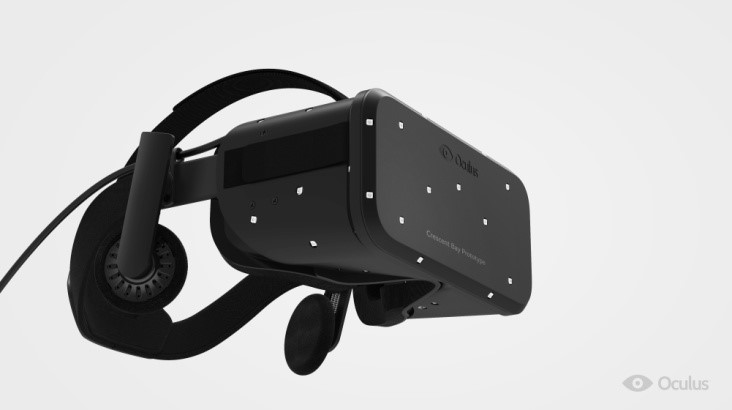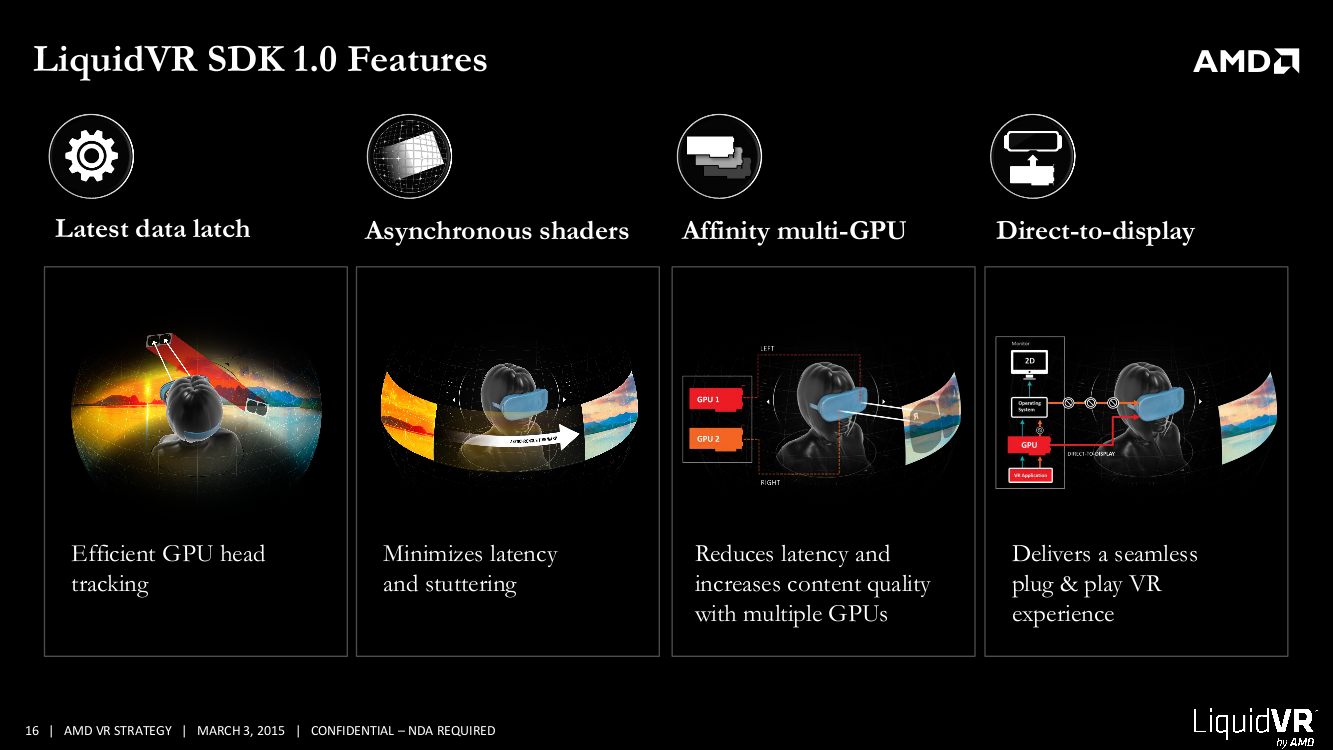AMD's Next Radeon Flagship Spotted Powering Oculus Rift
What that headline just told you isn't a surprise per se, but the fact that its existence is being unofficially confirmed now, if not officially named, and the manner in which I experienced it are, in fact, tasty surprises.
(That preamble is for that portion of you who will say "no duh it exists," and that portion who would harangue us for not saying something early if we knew, regardless of the official or unofficial status of this news. For the portion of you who must know right now all of the details, the when, the what, the how much, the how fast, we will just have to wait. But I get the sense we won't have to wait too long.)
Just to be clear, I saw a demonstration of Showdown running on the Oculus Rift Crescent Bay, being powered by an unannounced Radeon R9 flagship ultra-enthusiast product. Those words, in their exactness, were told to me officially, as in on the record, by AMD.
Showdown is an immersive experience where a giant robot is wreaking havoc on a city, causing flying debris (at you, around you), a flying car with a person inside, and explosions in 360 degrees, among many pieces of action. I saw Showdown last at CES in early January, and then it wasn't running on this AMD hardware (so presumably Nvidia's). I obviously cannot recall the nuances of that demo earlier this year for precise comparison, but I can say that the performance of this demonstration was remarkably responsive. I tried everything I could to throw off head tracking and introduce latency and I could not, which is to say I didn't experience any latency. The environment is incredibly rich in texture, lighting and immersion. On the other hand, at this point the demonstration is relatively short.
This comes on the heels of AMD's announcement of its virtual reality initiative, called LiquidVR, and the associated SDK, announced yesterday here at GDC. (You can read about the details of that here, and the key pieces of it are listed in the image above.) At a separate meeting this week, AMD emphasized that most of the work behind LiquidVR, especially aspects like Asynchronous Compute Engine (ACE), was already part of GCN, but was now being exposed via APIs.
Naturally, new hardware like this next Radeon R9 would come as a natural part of AMD's release cycle, but the idea that a new generation of graphics processing will be necessary for the experiences being promised in the Oculus Rift further heightens its importance. Earlier in the day, Nvidia CEO Jen-Hsun Huang stole some thunder (and maybe Nvidia's own, given that its GTC event is less than two weeks away) with an early announcement of the Titan X during Epic's presentation on Unreal. (You can read more details about that here.)
AMD representatives said the heavy lifting that a new Radeon engine and muscular APIs exposed through LiquidVR really just get us to a point where there's true comfort in a virtual reality experience. That is, all of the performance barriers to low latency are removed.
Get Tom's Hardware's best news and in-depth reviews, straight to your inbox.
That may sound like table stakes, and in many ways it is; and it may even disappoint many consumers to learn that it will require some pretty beefy hardware to take on the rich immersive experiences we keep hearing about or seeing in early demonstrations. Latency has to get below 11 milliseconds at 90 fps, without dropping a single frame. We are talking about the higher end of the virtual reality spectrum here, and it remains to be seen what lesser hardware can really do. Perhaps the mere novelty will be enough to satisfy manner consumers. But Oculus, AMD, Nvidia and others are aiming higher.
Once the technology achieves this basic level of performance, the real work begins, AMD representatives said, and the kind of quality we're seeing in PC gaming, especially when it comes to photo realism -- something both AMD and Epic stated as goals for future VR -- will start to take off.
I did see a few quick demonstrations of other aspects of LiquidVR. For example, AMD showed a simple demonstration application running at 65 fps, doing about 1000 draw calls. It then turned on the settings to enable Affinity multi-GPU and the frame rates essentially doubled, thus allowing the same 65 fps on each eye.
If it's not clear: VR is about to explode, and companies like AMD and Nvidia are clearly going to grab their piece of this. Or better yet, fuel it.
Bring it on, Captain.
Follow Fritz Nelson @fnelson. Follow us @tomshardware, on Facebook and on Google+.
-
DelightfulDucklings Would be nice to hear your thoughts on how Crescent Bay compares to DK2 in an opinion write up. Hopefully we see the next generation of GPUs from AMD shortly if they are already using them like thisReply -
Achoo22 Yawn... we were told the same thing back when Titanfall was in development and we were all going to be blown away playing it in VR upon its release. Wake me up when someone starts actually shipping products - unless, of course, they require "flagship ultra-enthusiast" counterparts. Anyone who uses the term "ultra-enthusiast" should immediately be punched in the mouth.Reply -
somebodyspecial I don't see myself ever wearing any "GEAR" on my head. Even hate headphones, but I use them if online in a fps, but that's about it. I'd always prefer NOTHING on my head, and surround speakers for most games. On top of not wanting something up there, I'm not excited about a tech that causes most to get headaches or nausea after mere hours or less. Unless they get this stuff down to $50 or something, it wouldn't be worth it to me. I say $50 because that is what I'm willing to pay for something I use very little (IE, less than headphones, if it still has the effects noted). It's a great idea, don't get me wrong. I might accept it more if it was less "on your head" like google glass or something (but both eyes, I just mean glasses), rather than looking like I'm going scuba diving ;) But I'm sure some will just drool over this stuff. But top end video cards+VR unit=low audience to me. I'd think most devs would rather aim at a 1.5B unit audience on mobile especially after everyone is X1 level gpu. Much easier to sell more units and be successful with those numbers.Reply
Also there won't be a ton of stuff out for this for years anyway as the audience is small. Devs don't even begin to write for consoles until 10mil units and they have a major fan base. I'm wondering how much effort the devs will have to put in to making a game use this tech on top of making a great game, which means if it's a LOT of effort watch quality drop or play time shrink even more - 5-10hrs? LOL. I'd rather see more stuff like Underworld Ascendant or Bard's Tale IV (yes #4!)
https://www.kickstarter.com/projects/othersidegames/underworld-ascendant
35hrs or so left on this one. Bard's Tale just starting up I guess. Torment, Tides of Numenera, Shroud of the Avatar, Shadowgun (just raised 1.2mil for their next shadowrun game) etc. Great games by smaller devs that bring back quality and LONGER play time for your money. IE, 10-15hrs for $60 vs. these little guys doing 15-60hrs of fun for $20-45. Opinions vary I'm sure. VR just isn't well spent money to me for games, thankfully it looks like only the big dogs are involved so we'll still get the great little guy's games anyway :) (fun for all then I guess). -
warezme No product, no cares. The industry has been waving these things in our faces for years now, always soon to be released whatever. I predict that even if they are released they will soon become like vision surround, 3d vision and 3d monitors and SLI cards. It all sounds great until all the incompatibilities and driver issues and lack of game support, etc, etc. crop up.Reply -
jossrik My little brother has an Oculus DK2, and I gotta say. It's awesome. My parents were blown away. And the worst part is, it's crap, there are no really game changing titles it's all little two minute demos (or nearly), the games that you can play in it were buggy. But as far as the experience. It was there. I liked it a lot, we had to get him a 290X to run it (This was before NVidias 9xx series came out, well before). But it is awesome. It's like going to the movies. It's an experience you can't duplicate. You may hate it, you know what, don't buy it, there are always people that want that big screen experience, and ya, you pay 15$ per person and a hundred and twelve dollars for a small popcorn, but for them, it's worth it. Nay sayers go back to your 15in monochromes and tell me you love them.Reply -
SteveCR I had the chance to experience DK2 as well. And I agree with jossrik, the experience is there. The game they demo'd was a crappy Mario like game, but even in that the feel of immersion is not something you'd be able to replicate through any other current mediums. So I personally think these head mounted displays will become mainstream wither we like it or not. I personally am holding off on purchasing another 28" (I have a tri-monitor setup of two 28's and one 24) screen because I think Oculus Rift is around the corner.Reply
-
yumri I think when real applications come to it it will sell alot of units but before you have any applications for the general consumers be it for general propose video watching or gaming or simulations or whatever VR is going to stay in the side lines and never come to the main stream due to just no demand so the developers have to make something that we want for it for it to take off. For this the game engine makers have to make it easier to make for as i cannot really find any game engine that offers good support for all the VR devices but a few with select support but not support for all.Reply -
123345 The fact, that facebook bought it for $2 billion says all ;)Reply
And up to now we only have Dk= Development Kits, these are for developers to learn to use the hardware and not for kiddies like you. Wait for the Consumer Version, then you will see a lot of big games coming. -
virtualban Browser plugin for VR helmet, now, that could have some potential. Everything is shown on both eyes, flat surface style, except for the stereo video/picture which will show on each eye.Reply
After that, a linux interface to make all the working environment like that at the very least, while MS still pushes for tablet experience on desktops. -
Yeah, and 3D was going to be the future. Except I don't know anyone that has one, heck, most of my friends don't own televisions.Reply
I don't want something heavy on my head for an extended period of time. Nor do I want to move my head to look around. This huge explosion, it's not going to happen.


